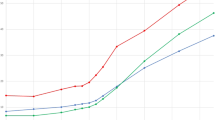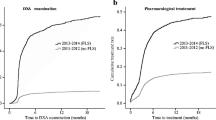Abstract
Summary
Mobile fracture prevention services, with DXA, significantly improved access to care for those at high risk of fracture living in rural areas. Introduction of mobile services facilitated access to fracture liaison services and development of integrated of care pathways across community- and secondary-based care.
Introduction
The ageing population is growing faster in rural areas, yet most fracture prevention services are located in urban areas. As part of a wider study, evaluating the introduction of mobile fracture prevention services, we focus on whether mobile services improve access to care for those at highest risk of fracture.
Methods
Services outcomes were assessed against the Royal Osteoporosis Society clinical standards for fracture liaison services. This included standardised, age-specific referral rates, FRAX 10-year probability of major osteoporotic and hip fracture of referrals, pre- and post-introduction of the mobile service across two island and one rural mainland sites. This was compared with referrals from a similar rural mainland region with local access to a comprehensive service.
Results
Greatest impact occurred in areas with most limited service provision at baseline. Mean age of patients referred increased from 59 to 68 years (CI 6.8–10.1, p < 0.001). Referral rates increased from 2.8 to 5.4 per 1000 population between 2011 and 2018, with a 5-fold rise in those ≥ 75 years (0.4 to 2.0 per 1000). Mean FRAX 10-year risk of major osteoporotic fracture increased from 12.7 to 17.7% (CI 3.2–5.7, p < 0.001). Mean hip fracture risk probability increased from 3.0 to 5.7% (CI 2.0–3.4, p < 0.001). However, referral rates from the mobile sites remained lower than the comparator site.
Conclusions
Mobile fracture prevention services, including DXA, greatly improved uptake amongst high-risk individuals. Mobile services facilitated development of integrated of care pathways, including fracture liaison services, across community- and secondary-based care.




Similar content being viewed by others
References
Marsh D, Akesson K, Beaton DE, Bogoch ER, Boonen S, Brandi ML et al (2011) Coordinator-based systems for secondary prevention in fragility fracture patients. Osteoporos Int 22(7):2051–2065
Ganda K, Puech M, Chen JS, Speerin R, Bleasel J, Center JR, Eisman JA, March L, Seibel MJ (2013) Models of care for the secondary prevention of osteoporotic fractures: a systematic review and meta-analysis. Osteoporos Int 24(2):393–406
Giangregorio L, Papaioannou A, Cranney A, Zytaruk N, Adachi JD (2006) Fragility fractures and the osteoporosis care gap: an international phenomenon. Semin Arthritis Rheum 35(5):293–305
Harvey NC, McCloskey EV, Mitchell PJ, Dawson-Hughes B, Pierroz DD, Reginster JY, Rizzoli R, Cooper C, Kanis JA (2017) Mind the (treatment) gap: a global perspective on current and future strategies for prevention of fragility fractures. Osteoporos Int 28(5):1507–1529
Hernlund E, Svedbom A, Ivergård M, Compston J, Cooper C, Stenmark J et al (2013) Osteoporosis in the European Union: medical management, epidemiology and economic burden: A report prepared in collaboration with the International Osteoporosis Foundation (IOF) and the European Federation of Pharmaceutical Industry Associations (EFPIA). Arch Osteoporos 8(1–2)
Royal College of Physicians (2018) Fracture liaison service database: commissioner’s report [Available from: https://www.rcplondon.ac.uk/projects/outputs/fracture-liaison-service-database-commissioners-report-2018
Greenspan SL, Wyman A, Hooven FH, Adami S, Gehlbach S, Anderson FA Jr et al (2012) Predictors of treatment with osteoporosis medications after recent fragility fractures in a multinational cohort of postmenopausal women. J Am Geriatr Soc 60(3):455–461
International Osteoporosis Foundation (2018) Broken bones, broken lives: a roadmap to solve the fragility fracture crisis in Europe [Available from: https://www.iofbonehealth.org/broken-bones-broken-lives
Rural Health Information Hub. Rural aging [Available from: https://www.ruralhealthinfo.org/topics/aging
Shergold I, Parkhurst G (2012) Transport-related social exclusion amongst older people in rural Southwest England and Wales. J Rural Stud 28(4):412–421
Speerin R, Slater H, Li L, Moore K, Chan M, Dreinhofer K et al (2014) Moving from evidence to practice: models of care for the prevention and management of musculoskeletal conditions. Best Pract Res Clin Rheumatol 28(3):479–515
Scottish Government (2015) Rural Scotland Key Facts 2015 [Available from: www.gov.scot/Resource/0047/00473312.pdf
Smith KB, Humphreys JS, Wilson MG (2008) Addressing the health disadvantage of rural populations: how does epidemiological evidence inform rural health policies and research? Aust J Rural Health. 16(2):56–66
Scottish Government (2018) Rural Scotland Key Facts [Available from: https://www.gov.scot/publications/rural-scotland-key-facts-2018/
Asthana S, Halliday J (2004) What can rural agencies do to address the additional costs of rural services? A typology of rural service innovation. Health Soc Care Community 12(6):457–465
Newman ED, Ayoub WT, Starkey RH, Diehl JM, Wood GC (2003) Osteoporosis disease management in a rural health care population: hip fracture reduction and reduced costs in postmenopausal women after 5 years. Osteoporos Int 14(2):146–151
Newman ED, Olenginski TP, Perruquet JL, Hummel J, Indeck C, Wood GC (2004) Using mobile DXA to improve access to osteoporosis care: unit design, program development, implementation, and outcomes. J Clin Densitom 7(1):71–76
Tucker K, Schultz CG, Chatterton BE (1997) Mobile bone densitometry service in Rural South Australia. Anz Nucl Med 28:28–29
National Osteoporosis Society (2011) National Osteoporosis Society Osteoporosis Scanning Services Development Programme: final report [Available from: https://www.nos.org.uk/document.doc?id=923
Hollick RJ, Black AJ, Reid DM, McKee L (2019) Shaping innovation and coordination of healthcare delivery across boundaries and borders. J Health Organ Manag 33(7/8):849–868
Royal Osteoporosis Society (2019) Effective secondary prevention of fragility fractures: clinical standards for fracture liaison services [Available from: https://theros.org.uk/media/100702/royal-osteoporosis-society-clinical-standards-for-fracture-liaison-services.pdf
Scottish Intercollegiate Guidelines Network. SIGN 142 (2015) Management of osteoporosis and the prevention of fragility fractures: a national clinical guideline [Available from: http://www.sign.ac.uk/guidelines/fulltext/142/index.html]
National Statistics Scotland (2012) Scottish Index of Multiple Deprivation. [Available from: http://simd.scotland.gov.uk/publication-2012/simd-2012-results/domain-results/geographic-access-domain/
National Records Scotland (2019) Mid-year population estimates [Available from: https://www.nrscotland.gov.uk/statistics-and-data/statistics/statistics-by-theme/population/population-estimates/mid-year-population-estimates/mid-2018
NHS National Services Scotland (2018) Scottish hip fracture audit: hip fracture care pathway report [Available from: https://www.shfa.scot.nhs.uk/Reports/_docs/2018-08-21-SHFA-Report.pdf
Curtis JR, Laster A, Becker DJ, Carbone L, Gary LC, Kilgore ML et al (2009) The geographic availability and associated utilization of dual-energy X-ray absorptiometry (DXA) testing among older persons in the United States. Osteoporos Int 20(9):1553–1561
Clunie G, Stephenson S (2008) Implementing and running a fracture liaison service: an integrated clinical service providing a comprehensive bone health assessment at the point of fracture management. J Orthop Nurs 12(3):159
Leslie WD, MacWilliam L, Lix L, Caetano P, Finlayson GS (2005) A population-based study of osteoporosis testing and treatment following introduction of a new bone densitometry service. Osteoporos Int 16(7):773–782
Rubin KH, Abrahamsen B, Hermann AP, Bech M, Gram J, Brixen K (2011) Prevalence of risk factors for fractures and use of DXA scanning in Danish women. A regional population-based study. Osteoporos Int 22(5):1401–1409
Haikel RL Jr, Mauad EC, Silva TB, Mattos JS, Chala LF, Longatto-Filho A et al (2012) Mammography-based screening program: preliminary results from a first 2-year round in a Brazilian region using mobile and fixed units. BMC Womens Health 12:32
Haiart DC, McKenzie L, Henderson J, Pollock W, McQueen DV, Roberts MM, Forrest AP (1990) Mobile breast screening: factors affecting uptake, efforts to increase response and acceptability. Public Health 104(4):239–247
Naeim A, Keeler E, Bassett LW, Parikh J, Bastani R, Reuben DB (2009) Cost-effectiveness of increasing access to mammography through mobile mammography for older women. J Am Geriatr Soc 57(2):285–290
Leese GP, Boyle P, Feng Z, Emslie-Smith A, Ellis JD (2008) Screening uptake in a well-established diabetic retinopathy screening program: the role of geographical access and deprivation. Diabetes Care 31(11):2131–2135
Massin-Short SB, Grullon MA, Judge CM, Ruderman KR, Grullon M, Lora V (2010) A mobile mammography pilot project to increase screening among Latina women of low socioeconomic status. Public Health Rep 125(5):765–771
Sparks BT, Ragheb NE, Given BA, Swanson GM (1996) Breast cancer screening in rural populations: a pilot study. J Rural Health 12(2):120–129
Lee SJ, McCarty CA, Taylor HR, Keeffe JE (2001) Costs of mobile screening for diabetic retinopathy: a practical framework for rural populations. Aust J Rural Health 9(4):186–192
Lesjak MS, Flecknoe-Brown SC, Sidford JR, Payne K, Fletcher JP, Lyle DM (2010) Evaluation of a mobile screening service for abdominal aortic aneurysm in Broken Hill, a remote regional centre in far western NSW. Aust J Rural Health. 18(2):72–77
Brundisini F, Giacomini M, DeJean D, Vanstone M, Winsor S, Smith A (2013) Chronic disease patients’ experiences with accessing health care in rural and remote areas: a systematic review and qualitative meta-synthesis. Ont Health Technol Assess Ser 13(15):1–33
Rothmann MJ, Ammentorp J, Bech M, Gram J, Rasmussen OW, Barkmann R, Glüer CC, Hermann AP (2015) Self-perceived facture risk: factors underlying women’s perception of risk for osteoporotic fractures: the Risk-stratified Osteoporosis Strategy Evaluation study (ROSE). Osteoporos Int 26(2):689–697
Litwic AE, Compston JE, Wyman A, Siris ES, Gehlbach SH, Adachi JD et al (2017) Self-perception of fracture risk: what can it tell us? Osteoporos Int 28(12):1433–2965 (Electronic)
Lamont T, Barber N, de Pury J, Fulop N, Garfield-Birkbeck S, Lilford R et al (2016) New approaches to evaluating complex health and care systems. BMJ. 352:i154
Shepstone L, Lenaghan E, Cooper C, Clarke S, Fong-Soe-Khioe R, Fordham R et al (2018) Screening in the community to reduce fractures in older women (SCOOP): a randomised controlled trial. Lancet. 391(10122):741–747
Rubin KA-OX, Rothmann MJ, Holmberg T, Hoiberg M, Moller S, Barkmann R et al (2018) Effectiveness of a two-step population-based osteoporosis screening program using FRAX: the randomized Risk-stratified Osteoporosis Strategy Evaluation (ROSE) study. Osteoporos Int 29(3):1433–2965 (Electronic)
McCloskey E, Johansson H, Harvey NC, Shepstone L, Lenaghan E, Fordham R, Harvey I, Howe A, Cooper C, Clarke S, Gittoes N, Heawood A, Holland R, Marshall T, O’Neill TW, Peters TJ, Redmond N, Torgerson D, Kanis JA, SCOOP Study Team (2018) Management of Patients with high baseline hip fracture risk by FRAX reduces hip fractures-a post hoc analysis of the SCOOP study. J Bone Miner Res 33(6):1020–1026
Acknowledgements
We would also like to thank all patients and staff who kindly gave their time and expertise to participate in this research, in particular specialist radiographers Lana Gibson, Ros Holmes, and Diane Smith who delivered the service.
Funding
The authors would like to thank the Grampian Osteoporosis Trust for funding the purchase of the mobile DXA scanner and the set-up costs of the service, and the University of Aberdeen Development Trust for funding the project evaluation.
Author information
Authors and Affiliations
Corresponding author
Ethics declarations
Conflicts of interest
None.
Additional information
Publisher’s note
Springer Nature remains neutral with regard to jurisdictional claims in published maps and institutional affiliations.
Electronic supplementary material
ESM 1
(DOCX 79 kb).
Rights and permissions
About this article
Cite this article
Hollick, R., McKee, L., Shim, J. et al. Introducing mobile fracture prevention services with DXA in Northern Scotland: a comparative study of three rural communities. Osteoporos Int 31, 1305–1314 (2020). https://doi.org/10.1007/s00198-020-05316-0
Received:
Accepted:
Published:
Issue Date:
DOI: https://doi.org/10.1007/s00198-020-05316-0




